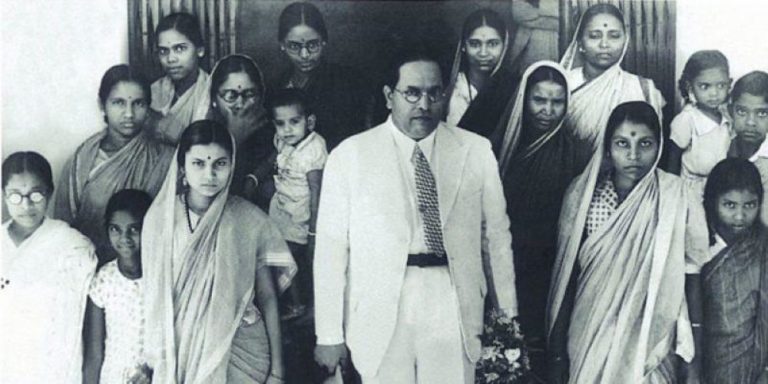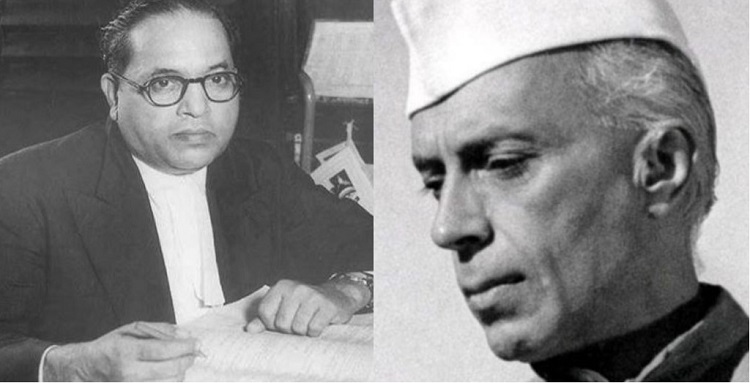
In 1948, Nehru entrusted the drafting of the new code to Ambedkar. It was felt by the cabinet, especially Nehru and Ambedkar, that codifying Hindu law would, to a great extent, check the injustices suffered by Hindu women
Praveen Davar
Just as the mere mention of November 14 reminds one of Jawaharlal Nehru, the architect of modern India, April 14 instantly brings to mind the stellar contributions of Dr. B.R. Ambedkar, architect of India’s constitution.
The revolutionary changes in Hindu law regarding marriage, divorce and inheritance were primarily the work of the two great men – Jawaharlal Nehru and Babasaheb Ambedkar. He was inducted into the Nehru cabinet in August 1947 even though he was in the opposition.
In 1948, Nehru entrusted the drafting of the new code to Ambedkar. It was felt by the cabinet, especially Nehru and Ambedkar, that codifying Hindu law would, to a great extent, check the injustices suffered by Hindu women. The life mission of both the first prime minister and the first law minister was to bring equality in Indian society and end all discrimination based on caste, race, religion and gender. But no sooner was the Bill introduced than there was vehement opposition to it from orthodox Hindu elements in the country. Even Rajendra Prasad, the President of India, was opposed to the idea and desired its postponement, but the prime minister politely declined to do so, telling the president “it is difficult for me to override the cabinet decision in this matter”.
Even though the cabinet had decided to introduce the Hindu Code Bill in February 1951, it was postponed to the next session of Parliament to be taken up in the first week of September. Ambedkar wrote to Nehru that in view of the former’s ill health, which demanded immediate and long-term treatment, the Bill should be taken up in mid-August and completed by September. But there were more urgent Bills to be taken up and it was not possible to advance the introduction of the Hindu Code Bill.
Meanwhile, more opposition built up against the Bill. Jana Sangh leader Syama Prasad Mookerjee issued a public statement against it. “The magnificent structure of Hindu culture will stultify a dynamic and catholic way of life that had wonderfully adapted itself to changes for centuries,” he said. The reservations of the orthodox in parliament were supplemented in the streets by RSS cadres. They shouted slogans against Nehru and Ambedkar: “Down with the Hindu Code Bill” and “Pandit Nehru Murdabad”.
One saffron-clad swami even went to the extent of saying that an “untouchable” had no business meddling in matters normally the preserve of Brahmins. Within parliament, many conservative members claimed that Hindu laws had stayed unchanged since the Vedic times. One member, Ramnarayan Singh, stated: “Despite the challenges posed by Buddhism, Islam and Christianity the Vedic religion did not perish … we have now Pandit Nehru’s administration, whose representative Dr. Ambedkar wants to abrogate with a single stroke all those rules which have existed since the beginning of the world.”
On September 15, 1951, President Rajendra Prasad sent a note to Prime Minister Nehru expressing a desire to act solely on his own judgment, independently of the council of ministers. He maintained that the Provisional Parliament did not have the authority to enact such major legislation because it was indirectly elected and its members lacked the “public mandate” of a general election. He desired to use the power of his office either to force the Provisional Parliament to shelve the measure or, failing that, to veto it even against the advice of the cabinet.
 The credit for the greatest step for women’s empowerment, before the Rajiv Gandhi government initiated the Panchayati Raj Bill, giving 33% reservation to women, goes to both Nehru and Ambedkar
The credit for the greatest step for women’s empowerment, before the Rajiv Gandhi government initiated the Panchayati Raj Bill, giving 33% reservation to women, goes to both Nehru and Ambedkar
Nehru wrote to Prasad the same day: “It is true that when any social or economic changes are proposed in an existing structure of society, there are always some elements which are strongly in favor of them and some opposed to them very strongly. No reform can take place if this opposition is considered to be an adequate bar to change. The mere fact of long established static conditions can hardly be considered an argument for no change, even though facts otherwise warrant it.”
However, due to stiff opposition both within and without parliament, the Bill could not be moved despite the best efforts of Nehru. In view of the heavy business before the House and the short time at its disposal before the session ended, it was decided to concentrate on passing – as a separate measure – Part II of the Bill, namely, that dealing with marriage and divorce. Yet even Part II of the Bill could not be passed and was dropped on September 22, 1951. With utter disappointment, Ambedkar remarked: “It was killed and buried, unwept and unsung after four clauses were passed.” Finally, he resigned from Nehru’s cabinet on September 27, 1951.
Besides the non-passage of the Hindu Code Bill, there were other reasons Ambedkar resigned from the cabinet. First, his differences with Nehru on Kashmir policy and foreign policy in general. Secondly, he was deeply distressed with the treatment accorded to the Scheduled Castes and Other Backward Classes who were suffering from the “same old injustice, the same old oppression, and the same old discrimination which existed before”. Thirdly, he wanted the stewardship of the Planning Commission in the place of the law ministry, which did not materialize. Ambedkar’s resignation was followed by a decision of far-reaching consequences – his decision to renounce Hinduism and embrace Buddhism.
However, the Hindu Code Bill was later split into four Bills, and these were put on the Statute Book by Parliament after the elections to the first Lok Sabha in 1952. By this time, Rajendra Prasad, overwhelmed by the popularity of Nehru, as shown by the result of the first Lok Sabha election – Congress won 364 out of 489 seats – didn’t raise any objection. But Mookerjee and his Bharatiya Jana Sangh remained as opposed to the Bill as they were in 1951. The Hindu Marriage Act, 1955; the Hindu Succession Act, 1956; the Hindu Minority and Guardianship Act, 1956; and the Hindu Adoption and Maintenance Act, 1956 were the four enactments which incorporated the ideas and principles of the original Hindu Code Bill.
Although Ambedkar had resigned from cabinet in October 1951 in extreme bitterness, Nehru paid a generous tribute to him after the Dalit icon died in December 1956: “Dr. Ambedkar would be remembered, above all, as a symbol of revolt against all the oppressive features of Hindu society. He will be remembered also for the great trouble he took over the question of Hindu law reform. I am happy that he saw that reform in a very large measure carried out, perhaps not in the form of that monumental tome that he had himself drafted, but in separate bits.” Thus the credit for the Hindu code Bill, the greatest step for women’s empowerment, before the Rajiv Gandhi government initiated the Panchayati Raj Bill, giving 33% reservation to women, goes to both Nehru and Ambedkar.
______________________
(Praveen Davar, a former Army officer, is the author of Freedom Struggle & Beyond. Courtesy: The India Cable – a premium newsletter from The Wire & Galileo Ideas.)
Courtesy: Janata Weekly (Posted on April 23, 2023)